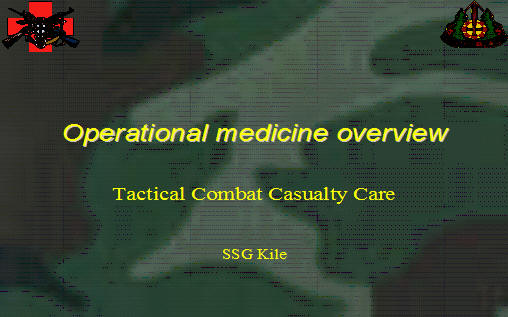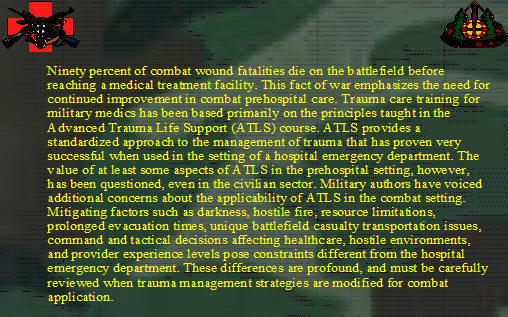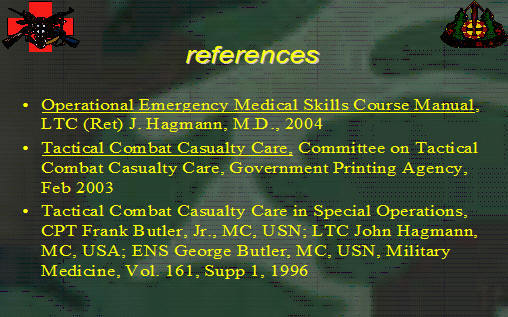Tactical Combat Casualty Care
Click here to download the presentation.



Operational medicine overview
Tactical Combat Casualty Care
references
Operational Emergency Medical Skills Course Manual, LTC (Ret) J. Hagmann, M.D., 2004
Tactical Combat Casualty Care, Committee on Tactical Combat Casualty Care, Government Printing Agency, Feb 2003
Tactical Combat Casualty Care in Special Operations, CPT Frank Butler, Jr., MC, USN; LTC John Hagmann, MC, USA; ENS George Butler, MC, USN, Military Medicine, Vol. 161, Supp 1, 1996
3 environments for care
HOSPITALS
TRADITIONAL PRE-HOSPITAL CARE
OPERATIONAL “OUT-OF-HOSPITAL” MEDICAL SUPPORT
HOSPITALS
Primarily deals with blunt trauma
Access to full range of specialist Physicians
Resource intensive
Advanced trauma care facilities, Intensive care units
ATLS procedures
Pre-surgical evaluation with access to full labs, blood banks, etc.
TRADITIONAL PRE-HOSPITAL CARE
Primarily deals with blunt trauma
Rapid response times
Well equipped and supported, utilizes EMT trained personnel
Advanced life support capabilities
Rapid transport and access to ambulances, helicopters, etc.
Short evacuation times (usually less than 1 hour away from hospital)
Strict medical control and use of protocols
OPERATIONAL “OUT-OF-HOSPITAL” MEDICAL SUPPORT
Most significant difference between this and the above are evacuation times of greater than 1 hour
Primarily deals with penetrating trauma
Independent providers
Austere environments
Echeloned care
May have delayed initial medical access (scene safety important)
In most cases limited to what medic can carry in aid-bag
Often pre-injury stressor is present (e.g. dehydration, sleep deprivation, stress of mission)
Operational field care
3 distinct areas
Care under fire
SECURITY!!
Limited to what is carried by medic and soldiers
Care based on MARCH acronym
M – Massive Bleeding
A – Airway
R – Respirations
C – Circulation
H – Head
Tactical field care
More secure
More Resources … still resource limited
ABC’s and Rapid Trauma Assessment
IV’s and Fluid Resuscitation
Dressings, Splints and Meds
CPR – Resuscitation on the battlefield for victims of blast or penetrating trauma who have no pulse, no respirations, and no other signs of life will not be successful and should not be attempted.
C-spine precautions
C-spine control: even with the neck supported in a C-collar, you do not prevent all neck injury
For penetrating trauma, C-spine control is unnecessary (blunt trauma tears vertebral ligaments requiring support). Penetrating injury blasts away ligaments, so if there is penetrating trauma then you already have C-spine trauma
Value – no one has shown conclusively that C-spine control can reduce the number of people who become paralyzed. For example, in Austria, an EMS system was established in the 1980’s using C-spine control but no differences were detected in numbers of patients who developed paralysis before and after introduction (does not mean it isn’t there).
C-spine control tends to be very resource intensive (manpower and medical management) that we do not use it except for very specific injuries where you think that there is a C-spine injury.
Standard medical procedures have been developed for the treatment of patients in the traditional pre-hospital and hospital environments where evacuations are usually achieved in less than 1 hour. These procedures are not always applicable to your work environment.
UNDERSTAND THE ENVIRONMENT YOU ARE WORKING IN!!
Mortality curve
Following trauma, the chances of a casualty surviving are dependant upon numerous variables, including the speed at which appropriate medical treatment is administered. During this discussion, we will look at the factors that can affect the chances of a casualty surviving as injury symptoms developing from initial penetrating trauma, through hemorrhage and/or respiratory compromise, to shock and infection.
Mortality curve
penetrating trauma
Lifesaving Measures
Hemorrhage Control
Airway management
Shock
Hemorrhage control
Tourniquet vs. Field Dressing
Alternate Means
Quickclot
Hemcon Dressing
Fibrin Bandage
Airway management
Resource Intensive methods v. Less intensive methods
Allow patient to sit up and manage own airway
O2 delivery
Naso v. Oral
Surgical Cricothyroidotomy v. Intubation
Needle Cric
shock
Shock is initially a physiological protection response that occurs in response to injury
Not a state your body slowly goes into because of injury
Stages
Compensated
Decompensated
Irreversible
Conclusion
Operational Environment is different from civilian pre-hospital environment.
Know your mission profile and understand your resources.
Right intervention at the Right time.
Regardless of Echelon assigned to… we ALL are Echelon I medics!
Questions??